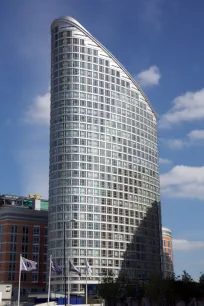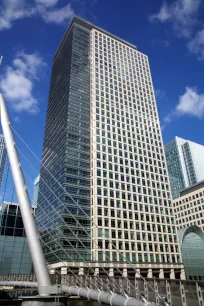Canary Wharf is a modern high-rise business district located at the former West India Docks on the Isle of Dogs, east of London. Some of the city’s tallest and most modern skyscrapers can be found here.
Docklands

The Docklands, a large area along the Thames riverfront on the eastern edge of London, was once home to the world’s busiest port.
In the 1960s, after the construction of the Thames Barrier – a storm surge barrier – and a modern container port in Tilbury, activity in the area came to a halt. The many wharves and warehouses fell into decay.



London Docklands Development Corporation
The first large-scale private development plan, the Canary Wharf Project, was launched in the mid-1980s. The Canadian developer Olympia & York bought the project and started construction in 1988 of what would become the heart of the Docklands redevelopment.
Canary Wharf Tower
The first office tower, Canary Wharf Tower (now One Canada Square), was built in 1990. At 800 ft (243 m) the pyramid-topped steel tower was the tallest building in Europe until the completion of the Messeturm in Frankfurt, Germany that same year.
Many more office towers were planned, but British corporations were reluctant to relocate to the remote site. Despite a promise by the prime minister, Margaret Thatcher, there was no underground connection and the site lacked shopping areas and restaurants. To make matters worse, in 1992 a recession caused the property market to collapse. The developer went into bankruptcy and the whole project seemed to be an enormous failure.
A Booming District
The tide turned during the second half of the 1990s. The property market revived, and the development project was bought by an international consortium backed by the former owners of Olympia & York.
And finally in 1999 the underground Jubilee line was extended to the Millennium Dome, with a stop at Canary Wharf. Now only thirty minutes from the heart of London, Canary Wharf started to attract more and more tenants, mostly financial institutions.
The working population in the area rose from 13,400 in 1996 to about 120,000 in 2022. Canary Wharf now boasts a cluster of skyscrapers and is already dubbed Manhattan on Thames. More importantly, the area also started to attract residents, a shopping mall, bars and restaurants.
Sights
There’s more to see in Canary Wharf than just modern high-rise buildings. The area is home to a couple of unique monuments and there’s even a museum.

One of the monuments is known as the Traffic Light Tree, a structure with seventy-five traffic lights created by the French artist Pierre Vivant. It was installed in 1998 to replace a dying tree and is said to represent the relentlessness of Canary Wharf. The eight-meter-tall monument is located at the edge of Canary Wharf, on a roundabout at Trafalgar Way.
Another interesting monument is the Centaur, a modern sculpture created by the Polish sculptor Igor Mitoraj. The surreal work, which shows the mythical figure of a horse with a male torso, was installed in 1992 at Montgomery Square.
Canary Wharf is also home to the Museum of the London Docklands, a museum that tells the history of the Docklands and the Thames River from the Roman times to today. The museum, which is housed in a large nineteenth-century warehouse on West India Quay, is a branch of the Museum of London. A statue in front of the museum commemorates Robert Milligan, a merchant and shipowner who built the West India Docks and controlled the trade on the import of goods from the West Indies.
- Next: Guildhall
- More Sights & Attractions in London

